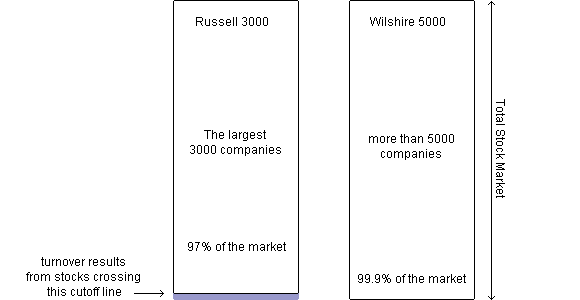Portfolio Turnover
Turnover - the buying and selling of stocks in a portfolio - is a natural enemy of growth, because it results in transaction costs and capital gains.
(See this calculator for more details.)
Index funds generally have much lower turnover rates than actively managed funds;
but even in the index world, design makes some indexes more efficient than others.
To take one clear-cut example, the Russell 3000 and Wilshire 5000 are both considered Total Stock Market indexes;
but the Russell 3000 has the constraint that it's supposed to contain exactly 3000 stocks; this obviously leads to turnover for the shares that cross the cutoff every year:

(Note that Wilshire "5000" is a misnomer: it has no constraint to hold any set number of stocks.)
Here's how the annual turnover rates for these two indexes have actually compared:
| Russell 3000 |
Wilshire 5000 |
| 12.7% |
4.6% |
Annual turnover rates, 2001-2003
These numbers are from chapter 8 of David Swensen's Unconventional Success,
which describes the logic of what makes an index "well constructed" or "poorly constructed" in terms of turnover.
For example, the S&P indexes are hand-picked in a way that deliberately reduces turnover;
so if you wanted to "tilt" your portfolio by overweighting small and mid caps, some choices would be more efficient than others:
Designing for Low Turnover
Some index styles really do require substantial turnover;
but even here, progress is being made.
|
For example, suppose you were designing a Small Value index, with cutoffs defined by market capitalization and P/E ratio.
If you implemented a hair-trigger trading methodology where a stock would have to be bought or sold the minute it crossed the cutoff levels, you'd get tremendous (and useless) turnover from all the stocks that are always jiggling around at the boundary.
|
|

|
|
The improved design is to replace the harsh cutoff line with a thick Do Nothing Zone.
The idea is that when a stock enters the zone, you do absolutely nothing, waiting until it pokes out on the other side before you trade.
(Incidentally, nobody really calls it a Do Nothing Zone.
DFA calls it a "hold or buffer range";
MSCI calls them "buffer zones that reduce index turnover caused by the temporary migration of securities from one style index to the other".)
Update: Russell implemented this strategy in 2007; this article
describes the impact of "banding" on turnover.
|
|

|
|